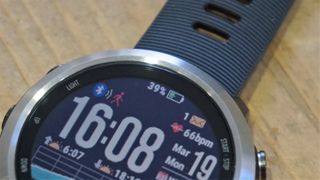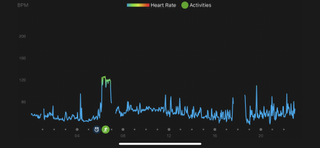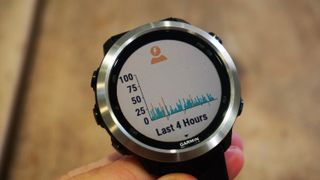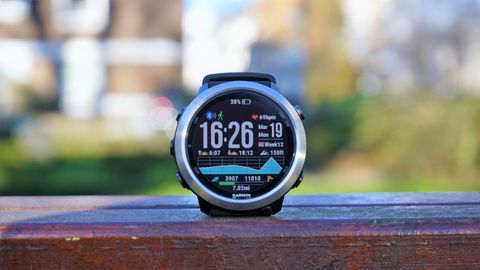Why you can trust TechRadar
- Battery life is poorer than other Garmin watches
- Around 10% battery lost per hour
Here’s the biggest issue we’ve got with the Garmin Forerunner 645 Music: it’s got poor battery life for a watch from this brand, when its watches are usually sterling at lasting.
Given it’s got the same screen size and operating system as the Forerunner 935, which can last for up to 10 days with daily activity, it’s maddening that the 645 can only manage 3-4 days.
What’s weird is it’s not the GPS tracking that munches the battery, nor the music playback. It’s just in general use that the issues come, with it falling to 8% after 16 miles run and a Bluetooth connection to a phone over four days.
Some more stats: we charged the watch to 100%, and took it on a 20 mile training run with music playback the entire time.

By the end of the run it was down to 65%, after 154 minutes of running. That’s not a bad stat at all, meaning even seven hour marathon runners should be able to track their race and have music the entire time. A good result.
But by the next day, we’d lost another 20% of the battery without any more GPS tracking or music playback… just having the heart rate and step tracking on.
It means you can’t feel confident in always having battery ready for a run like you do with other watches in the Garmin range… and it’s a shame.
Garmin is quoting five hours battery life in GPS mode, which is a lot shorter than many others in its watch line-up, so it knows that this is going to be one of the poorer options when it comes to holding charge.
If you’re going to exclusively use the Forerunner 645 for running with tunes, then you can expect a drop of 10-12% every hour of running, dropping to around 6-8% if you’re not using the Bluetooth streaming - with a similar result from cycling, as you’d expect.
So as only a running watch, it’s pretty good. But as a top-end all-day fitness tracker, as the Garmin watches often are, it’s quite poor.
Interface and activity tracking
- Slow interface
- Activity tracking is excellent

One of the more irritating things about the Garmin Forerunner 645 Music is that the interface is really, really slow at times.
We’re talking pressing a button to start a run and waiting two to three seconds just for the screen to change - even just taking a quick peek at your heart rate by pressing the down button will take a second.
It’s a long way from the snappy interface of the Apple Watch 3, and seems quite poor for a watch of this cost.
However, what the Forerunner 645 Music does do well is fitness tracking - like most of the high-end Garmin watches.
Sleep, step, heart rate and even stress tracking are all very well presented on the watch, meaning there are few devices that offer a more complete experience in terms of showing your overall fitness level.

The stress testing is among the most impressive, with the ability to read your heart rate variance (the difference in shape of each heart beat) and from that discern your stress levels.
It’s very accurate, and provides great insight - like how when you’re on a long-haul flight you’ll have a higher level of background stress than if you’re just sitting quietly at work or at home, which explains why long flights are always so much more stressful.

That heart rate variance can also pinpoint accurately your lactate threshold, meaning the Forerunner 645 can tell you with good accuracy when you’re going to start tiring in a race. It’s not a new feature to Garmin watches, but it’s really advanced and useful.
There’s also the ability to use the Forerunner 645 Music as a smartwatch, with the Bluetooth connection firing messages and phone calls to your wrist so you can respond or dismiss them accordingly.

If you’re using an Android smartphone you can even like certain social media posts or archive email - while rudimentary, we didn’t find we really wanted a lot more from a connected screen on our wrist, making the Garmin Forerunner 645 Music one of the better smartwatches around.
On top of all that, you’ve got the Garmin Connect app, which not only gives insight and advice on your fitness streaks (useful, if not a little rudimentary) but also gives long-range looks at your fitness levels.

Being able to see how your resting heart rate has improved, see how your daily stress level has moved or how well you’ve been sleeping is really cool, and all covered pretty accurately.
It would be nice to see this information used in a more cohesive way, fusing all three together with your effort levels in a run to give tailored information on how best to exercise, but that will surely come in the future.
From this app you can also download new watch faces or ‘apps’ from the ConnectIQ store, but these are little programs that add a small amount of functionality to the mix and aren’t super professional in the way they look - although you can get some nifty watch faces.

Gareth has been part of the consumer technology world in a career spanning three decades. He started life as a staff writer on the fledgling TechRadar, and has grown with the site (primarily as phones, tablets and wearables editor) until becoming Global Editor in Chief in 2018. Gareth has written over 4,000 articles for TechRadar, has contributed expert insight to a number of other publications, chaired panels on zeitgeist technologies, presented at the Gadget Show Live as well as representing the brand on TV and radio for multiple channels including Sky, BBC, ITV and Al-Jazeera. Passionate about fitness, he can bore anyone rigid about stress management, sleep tracking, heart rate variance as well as bemoaning something about the latest iPhone, Galaxy or OLED TV.

